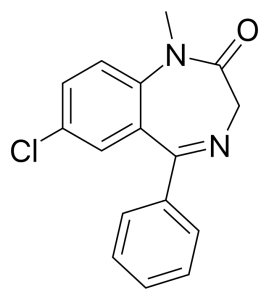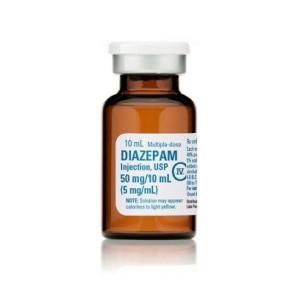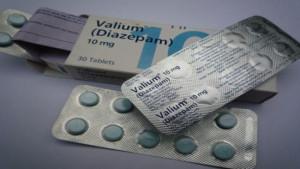
Diazepam
Description of the active substance Diazepam.
Formula: C16H13ClN2O, chemical name: 7-Chloro-1,3-dihydro-1-methyl-5-phenyl-2H-1,4-benzodiazepine-2-one.
Pharmacological group: neurotropic agents, antiepileptic agents; agents affecting neuromuscular transmission; anxiolytics, benzodiazepine derivative.
Pharmacological action: anticonvulsant, anxiolytic, central muscle relaxant, sedative, hypnotic.

Pharmacological properties
Diazepam acts on specific benzodiazepine receptors, which are located in postsynaptic GABA-receptor complexes in the thalamus, limbic system, hypothalamus, insertion neurons of the lateral horns of the spinal cord, activating the ascending reticular formation of the brain stem. Increases the sensitivity of GABA receptors to GABA, this determines an increase in the frequency of opening channels in the cytoplasmic membrane of neurons for incoming chlorine ions. All this leads to an increase in the inhibitory effect of GABA and inhibition of interneuronal transmission in the central nervous system. Anti-anxiety effects are manifested by the ability to relieve fear, inner anxiety, tension, anxiety. It has an amnesic and antipanic effect. In the treatment of sleep disorders, the use of diazepam as a hypnotic is advisable when simultaneously it is necessary to obtain anxiolytic effects throughout the day. Myorelaxing central effect is caused by inhibition of spinal polysynaptic reflexes. Diazepam has a pronounced anticonvulsant effect, which is used in epilepsy for the treatment of mental equivalents, convulsive paroxysms, to relieve epileptic status. In acute alcohol withdrawal, diazepam relieves the symptoms of arousal, nervous tension, anxiety, anxiety, tremor, and also reduces the signs and possibility of developing acute delirium, including hallucinations. Diazepam is effective in adults under parenteral administration in acute conditions that are accompanied by seizures, psychomotor agitation and other symptoms. Sedative effect appears when administered intravenously after a few minutes, when administered intramuscularly after 30-40 minutes. After the relief of acute manifestations of the disease, diazepam is then used orally. In anesthesiology, diazepam is used to reduce fear, tension, anxiety and acute stress reaction before surgery, as well as before complex (including diagnostic) interventions in surgery and therapy. In the latter cases, diazepam can reduce the patient’s memories of the procedures performed (cardiac catheterization, electropulse therapy, dislocation reduction, endoscopic procedures, bone fragments reposition, ligation of burn wounds, biopsy, and others). Diazepam increases the effectiveness of introductory anesthesia, the threshold of pain sensitivity, intraocular pressure, has an antiarrhythmic property, lowers blood pressure (with rapid intravenous administration). Reduces the secretion of gastric juice at night.
In experiments, it was shown that when ingested, LD50 diazepam is equal to 1240 mg / kg in rats and 720 mg / kg in mice. A study of reproduction in rats using diazepam before crossing at doses of 100, 80, 10, 1 mg/kg orally for 60-228 days showed that at doses of 100 mg/ kg, the number of offspring survival and pregnancies decreased. Doses less than 100 mg/kg did not affect neonatal survival. In studies in rabbits using diazepam at doses of 8, 5, 2, 1 mg/kg from the 6th to the 18th day of pregnancy, no teratogenic effects and adverse effects on reproduction were obtained. It is absorbed quickly and well (approximately 75% of the dose) when taken orally in the gastrointestinal tract. After administration, intramuscularly absorbed completely, but slower than when ingested. When administered rectally, the diazepam solution is absorbed quickly. The maximum concentration in the blood will be reached after 0.5–2 hours (after ingestion) and after 0.5–1.5 hours (when administered intramuscularly). When taken daily in the blood, the equilibrium concentration is reached after 5 days — 2 weeks. In the liver, diazepam (about 99%) undergoes biotransformation, and pharmacologically active metabolites are formed: oxazepam, desmethyldiazepam (nordiazepam) and temazepam. Diazepam and its active metabolites bind to plasma proteins (diazepam is approximately 98%), penetrate the placenta, the blood-brain barrier, and are found in breast milk. The volume of distribution of the drug at equilibrium is 0.8–1.0 l/kg. The half-life is up to 3.2 hours. In adults, the half–life is 20-70 hours (for diazepam), 30-100 hours (for nordiazepam), 9.5-12.4 hours (for temazepam), 5-15 hours (for oxazepam); in newborns, elderly patients and patients with liver diseases may increase; with renal insufficiency does not change. The clearance of diazepam is 20-30 ml/min. It is excreted mainly by the kidneys (up to 2% unchanged, about 70% in the form of metabolites) and with feces (about 10%). With repeated applications, there is an accumulation of diazepam with its active metabolites in the blood plasma.
Indications of diazepam
As a sedative, anxiolytic and hypnotic agent – in psychiatry and neurology: all types of anxiety disorders, including psychopathies, neuroses, psychopathic and neurosis-like states that are accompanied by fear, anxiety, emotional tension, increased irritability; anxiety syndrome in organic brain lesions, including cerebrovascular diseases, endogenous mental disorders diseases, including schizophrenia; paranoid-hallucinatory states, obsessive, senesto-hypochondriac and phobic disorders; motor arousal and somatovegetative disorders of various origins; sleep disorders; tension headache; vertebral syndrome; withdrawal syndrome;
in pediatrics: neurosis-like and neurotic conditions that are accompanied by anxiety, emotional tension, fear, irritability, sleep disorders, headache, enuresis, behavior and mood disorders;
in cardiology: myocardial infarction, angina pectoris, arterial hypertension;
in surgery and anesthesiology: premedication immediately before and on the eve of surgical interventions and endoscopic procedures, as a component of combined anesthesia, introductory anesthesia;
in gynecology and obstetrics: eclampsia, premature labor, labor facilitation, premature placental abruption; menstrual and menopausal psychosomatic disorders;
in dermatology: eczema and other diseases that are accompanied by irritability, itching.
As an anticonvulsant: epilepsy, severe recurrent epileptic seizures or epileptic status, tetanus.
As a muscle relaxant: spastic conditions of central genesis, which are associated with damage to the spinal cord or brain; spasms of skeletal muscles during injury; spastic conditions with other diseases of the support and movement system — myositis, progressive chronic polyarthritis, arthritis, bursitis, rheumatic spondylitis; arthrosis, which is accompanied by tension of skeletal muscles.

Method of administration of diazepam and dose
Diazepam is used intravenously, orally, rectally, intramuscularly. The regimen and doses are set strictly individually. Therapy should start with the lowest effective dose that corresponds to a specific disease. Usually, for adults, oral doses are: initial — 5-10 mg, daily — 5-20 mg, maximum single — 20 mg, maximum daily 60 mg, taken regardless of food intake, washed down with water. When administered intramuscularly or intravenously for adults, the average single dose is 10 mg, the average daily dose is 30 mg, the maximum single dose is 30 mg, the maximum daily dose is 70 mg. The duration of use of diazepam parenterally should not be more than 3-5 days (then, if necessary, the drug is taken orally), the total duration of therapy should be as short as possible and should not exceed 2-3 months. An increase in the duration of therapy for more than 2-3 months is possible only after repeated careful assessment of the patient’s condition. Before a second course of treatment, a break of at least 3 weeks is required. The duration of treatment and the dose for children are selected individually, depending on body weight, age and nature of the disease. Elderly patients, patients with impaired liver function should start therapy with smaller doses. It is necessary to cancel the treatment gradually, under the supervision of a doctor.
If you miss the next intake of diazepam, you should immediately contact your doctor.
It should be remembered that tension or anxiety, which are associated with everyday stress, usually do not require therapy with anxiolytics.
You can not mix diazepam and other drugs in one syringe. Intravenous injection should be performed slowly and into large veins, controlling the function of respiration. It is necessary to avoid getting the solution into the extravasal space and into the arteries. It is not necessary to carry out monotherapy with benzodiazepines when depression and anxiety are combined (suicide attempts are possible). Due to the possibility of developing paradoxical reactions, including aggressive behavior, it is necessary to use caution in patients with behavioral and personal disorders (such reactions are more often observed in children and the elderly), when they occur, the drug is canceled. During diazepam therapy, alcoholic beverages should not be consumed. It should not be used when working for drivers and people whose activities require a quick physical and mental reaction, and are also associated with high concentration of attention. The use of diazepam in patients under 14 years of age is permissible only in clearly justified cases, the duration of therapy should be minimal.
When using diazepam, it is possible to develop addiction and the formation of mental and physical dependence. The possibility of addiction increases with the use of high doses and with an increase in the duration of treatment, as well as in patients who have a history of alcohol and drug dependence. It is necessary to cancel the drug gradually, by lowering the dose, in order to reduce the possibility of developing rebound syndrome and withdrawal syndrome. With abrupt withdrawal of the drug after long—term administration or use of large doses, withdrawal syndrome occurs (muscle and headache, anxiety, anxiety, confusion, convulsions, tremor), in severe cases – hallucinations, depersonalization, epileptic seizures. Transient syndrome, in which the symptoms that caused the use of diazepam are resumed in a more pronounced form (rebound syndrome), can also be accompanied by anxiety, mood changes and other disorders.
With prolonged use of diazepam, it is necessary to periodically monitor the work of the liver and the picture of peripheral blood. The use of doses of more than 30 mg for 15 hours before delivery in a newborn can cause apnea, hypothermia, hypotension, breast rejection and other symptoms. There are cases of benzodiazepine addiction.
Contraindications to use
Hypersensitivity, severe liver failure, acute kidney and liver diseases, severe myasthenia gravis, alcohol or drug addiction (except for acute withdrawal syndrome therapy), suicidal tendencies, severe respiratory failure, spinal and cerebral ataxia, severe hypercapnia, angle-closure glaucoma, acute glaucoma attack, pregnancy (1 trimester), age up to 30 days, breast-feeding.
Restrictions on use
Chronic respiratory failure, severe renal impairment, sleep apnea syndrome, open-angle glaucoma (during treatment), age up to 6 months (only in hospital and for vital indications), pregnancy (2nd and 3rd trimesters).
Use during pregnancy and lactation
Use during breastfeeding and in the 1st trimester of pregnancy is contraindicated. Use in the 2nd and 3rd trimesters of pregnancy is possible only when the intended benefit to the mother is higher than the possible risk to the fetus.

Side effects of diazepam
Digestive system: violation of salivation (hypersalivation or dry mouth), constipation, nausea, jaundice, increased activity of alkaline phosphatase and liver transaminases;
blood and circulatory system: neutrophilia, bradycardia;
nervous system and sensory organs: lethargy, fatigue, drowsiness, ataxia, blurred vision, dulling of emotions, diplopia, tremor, nystagmus, decreased concentration and speed of reactions, dizziness, deterioration of short-term memory, blurred speech, dysarthria, confusion, fainting, depression, headache, paradoxical reactions (anxiety, acute arousal, hallucinations, fits of rage, nightmares, inappropriate behavior), anterograde amnesia;
other: allergic reactions (rash, urticaria), urinary retention, urinary incontinence, changes in libido.
When used parenterally: reactions at the injection site (phlebitis, thrombosis, formation of infiltrates), with rapid intravenous administration — cardiovascular collapse, hypotension, hiccups, impaired respiratory function. It is possible to develop drug dependence, addiction, aftereffect syndrome (decreased performance, muscle weakness), withdrawal syndrome, rebound syndrome.
Interaction of diazepam with other substances
It enhances the effects of alcohol, hypotensive and anticonvulsant drugs, tricyclic antidepressants, neuroleptics, analgesics, hypnotics, muscle relaxants, general anesthetics, antihistamines (which have a sedative effect). Psychostimulants, analeptics reduce the activity of diazepam. Antacids can reduce the absorption rate of diazepam, but not its degree. Isoniazid inhibits the elimination of diazepam. Microsomal oxidation inhibitors (including cimetidine, fluvoxamine, ketoconazole, omeprazole, fluoxetine) change the pharmacokinetics and increase the duration of the effects of diazepam. Rifampicin reduces the level of diazepam in the blood. Erythromycin inhibits the metabolism of diazepam in the liver. Diazepam can change plasma concentrations of phenytoin.
Overdose
With an overdose of diazepam, the central nervous system is depressed (from drowsiness to coma): lethargy, severe drowsiness, weakness, ataxia, inhibition of reflexes, decreased muscle tone, prolonged confusion, coma; respiratory depression, hypotension are also possible. It is necessary to induce vomiting and take activated charcoal (if the patient is conscious), rinse the stomach through a probe (if the patient is unconscious), symptomatic treatment, monitoring of vital functions, intravenous fluids (to enhance diuresis), if necessary, ventilator. With the development of arousal, barbiturates should not be used. As an antidote, use the benzodiazepine receptor antagonist flumazenil (only in a hospital setting). Hemodialysis is practically not effective.
Trade names of drugs with the active substance diazepam
Valium Rosh
Apaurin
Diazepam
Diazepabene
Diazepam Nicomed Diazepex
Diazepam-ratiopharm
Diapam
Relium
Relanium ® Sibazon
Seduxenum
Sibazona tablets
Sibazone solution for injection 0.5%
